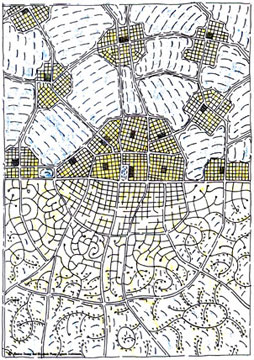Good design – applied to neighborhoods

What area of business do more companies need to invest in to provide more appealing products and services for their customers? As the leading magazine for innovation in business, Fast Company calls attention to the power of design, “The evidence of design’s power is everywhere. It’s apparent in the mere fact that the bar has been raised. Customers expect, even demand, more from the design of everything they buy.”
Does this apply to neighborhoods as well? You bet. Take the comparison of two neighborhood designs in this image, both with the same population size, geared toward two distinctive markets:
The neighborhood design on the top half features:
– Convenient retail/entertainment centers in each neighborhood
– More affordable housing (smaller lots, smaller homes)
– Less home/yard maintenance (smaller lots, smaller homes)
– Diversity of housing types, with condos/apartments at the centers, with rowhouses then single-family surrounding them
– Walkable (retail/entertainment/office/transit to work are located at centers)
– Close and frequent access to parks, wilderness, natural bike paths, recreation
The neighborhood design on the bottom half features:
– Big homes and big yards
– Lots of isolation and privacy
What’s the big deal? For the customers who preferred the first design, they were pretty much out of luck between the 1930s and 1990s. Thank goodness for them design is once again at the forefront of our economy versus mass production.
Image provided by world renowned town planners DPZ & Company.

Agreed! The key to creating real value in today’s world is by making things special and sustainable — good design is a huge part of this. As a design enthusiast, I’m happy to see the trend going mainstream — everything from hand soap (Method rules!) to national residential developers.